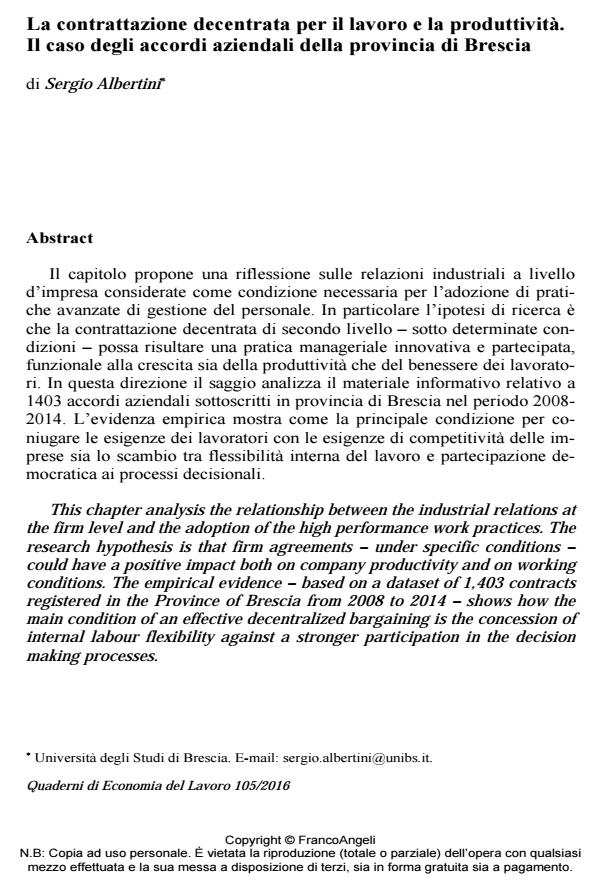La contrattazione decentrata per il lavoro e la produttività. Il caso degli accordi aziendali della provincia di Brescia
Journal title QUADERNI DI ECONOMIA DEL LAVORO
Author/s Sergio Albertini
Publishing Year 2017 Issue 2016/105 Language Italian
Pages 18 P. 191-208 File size 186 KB
DOI 10.3280/QUA2016-105010
DOI is like a bar code for intellectual property: to have more infomation
click here
Below, you can see the article first page
If you want to buy this article in PDF format, you can do it, following the instructions to buy download credits

FrancoAngeli is member of Publishers International Linking Association, Inc (PILA), a not-for-profit association which run the CrossRef service enabling links to and from online scholarly content.
This chapter analysis the relationship between the industrial relations at the firm level and the adoption of the high performance work practices. The research hypothesis is that firm agreements - under specific conditions - could have a positive impact both on company productivity and on working conditions. The empirical evidence - based on a dataset of 1,403 contracts registered in the Province of Brescia from 2008 to 2014 shows how the main condition of an effective decentralized bargaining is the concession of internal labour flexibility against a stronger participation in the decision making processes
- ADAPT (2016). La contrattazione collettiva in Italia (2015). Il Rapporto ADAPT. ADAPT University Press.
- Albertini S., Leoni R., a cura di (2009). Innovazioni organizzative e pratiche di lavoro nelle imprese industriali del Nord. Milano: FrancoAngeli.
- Banca D’Italia (2013). Indagine sulle imprese industriali e dei servizi. Supplementi al Bollettino Statistico – Indagini Campionarie. Roma.
- Cappelli P., Neumark D. (2001). Do High Performance Work Practices Improve Establishment-Level Outcomes? Industrial and Labour Relations Review, 54(4): 737-775.
- CISL - Dipartimento Lavoro Formazione Contrattazione, OCSEL – Osservatorio Sulla Contrattazione (2015). Caratteristiche e tendenze della contrattazione di secondo livello negli anni 2013-2014. Report 2015.
- CNEL-ISTAT (2015). Progetto CNEL-ISTAT: Produttività, struttura e performance delle imprese esportatrici, mercato del lavoro e contrattazione decentrata. Roma, agosto.
- Croucher R., Rizov M. (2009). Human resource management and performance in European firms. Cambridge Journal of Economics, 33: 253-272.
- D’Amuri F., Giorgiantonio C. (2014). Diffusione e prospettive della contrattazione aziendale in Italia. Occasional Papers, n. 221. Banca D’Italia.
- Grandori A. (2015). 10 Tesi sull’impresa. Contro I luoghi comuni dell’economia. Bologna: il Mulino.
- Leoni R. (2013). Organization of Work Practices and Productivity: an Assessment of Research on World-Class Manufacturing. In: Grandori A., a cura di, Handbook of Economic Organization. Integrating Economic and organization Theory. Cheltenham: Edward Elgar.
- OSMER (2016). Primo rapporto sulla contrattazione decentrate della provincia di Brescia. Università degli Studi di Brescia (in corso di pubblicazione).
- Pache A. C., Santos F. (2013). Inside the hybrid organizations: selective coupling as a response to competing institutional logics. Academy of Management Journal, 56(4): 972-1001.
- Signoretti A. (2014). Analysis of Italian medium-sized enterprises’ collective bargaining from an international perspective: Evidence from the manufacturing sector. Economic and Industrial Democracy, 1-23.
Sergio Albertini, La contrattazione decentrata per il lavoro e la produttività. Il caso degli accordi aziendali della provincia di Brescia in "QUADERNI DI ECONOMIA DEL LAVORO" 105/2016, pp 191-208, DOI: 10.3280/QUA2016-105010